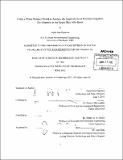Using a water balance model to analyze the implications of potential irrigation development in the Upper Blue Nile Basin
Author(s)
Jain Figueroa, Anjuli
DownloadFull printable version (23.62Mb)
Other Contributors
Massachusetts Institute of Technology. Technology and Policy Program.
Advisor
Dennis McLaughlin and Elfatih A. B. Eltahir.
Terms of use
Metadata
Show full item recordAbstract
More than 200 rivers in the world cross at least one political border. Any development project including hydropower or irrigation that is implemented in a trans-boundary river is in essence a claim on the resource. Managing a trans-boundary resource will require coupling not only of the physical aspect, but also the economics and political state of the region. The goal in this thesis is to study one case of a trans-boundary river: the Nile. The Nile is shared by 10 countries, but the case study will focus on the three countries that constitute the Eastern Nile region: Egypt, Sudan, and Ethiopia. In particular, the paper focuses on Ethiopia's irrigation potential in the Upper Blue Nile basin (UBN) and seeks to understand the physical constraints, the maximum water use, and the downstream hydrological and political impacts of developing irrigation. The approach taken is to construct a physically based optimization model in the General Algebraic Modeling System (GAMS) to determine the upper bound of water withdrawal possible by Ethiopia, paying particular attention to seasonal variability. The results show that both land and climate constraints impose significant limitations on agricultural production in the UBN. Only 25% of the land area is considered arable and suitable for irrigation due to the soil, slope and temperature conditions. When precipitation is also considered, on an annual average, only 11% of current land area could be used in a way that increases water consumption. The results suggest that Ethiopia could consume an additional 3.75 billion cubic meters (bcm) of water per year, through changes in land use and storage capacity, representing a 70 percent increase over existing water use. By exploiting this irrigation potential, Ethiopia could potentially decrease the annual flow downstream of the UBN by 8 percent.
Description
Thesis (S.M. in Technology and Policy)-- Massachusetts Institute of Technology, Engineering Systems Division, Technology and Policy Program, 2012. Cataloged from PDF version of thesis. Includes bibliographical references (p. 120-130).
Date issued
2012Department
Massachusetts Institute of Technology. Engineering Systems Division; Technology and Policy ProgramPublisher
Massachusetts Institute of Technology
Keywords
Engineering Systems Division., Technology and Policy Program.